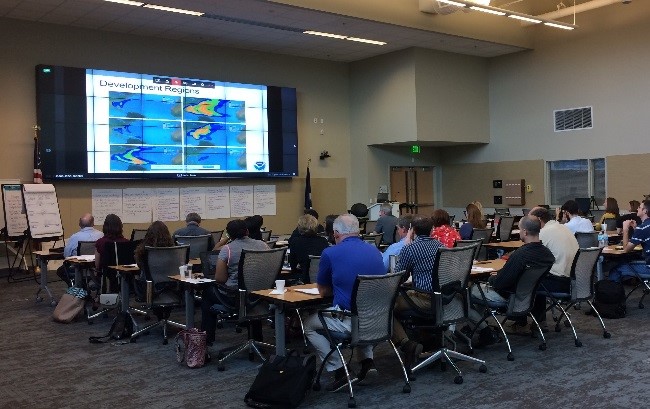NOAA's "Science of Coastal Natural Hazards" Course June 19-21 in Mobile
APRIL 27, 2018 — NOAA's Gulf of Mexico Disaster Response Center (DRC) is currently accepting applications for the "NOAA's Science of Coastal Natural Hazards" Course on June 19-21, 2018 in Mobile, Alabama.

The goal of the course is to enhance understanding of the risks, physical processes, and NOAA products and services related to coastal natural disasters available to improve decision making and planning in the Southeast, Gulf and Caribbean Regions.
During the course, participants can expect to learn about physical processes associated with each disaster type, information and tools necessary to improve on the job decision making and planning for coastal natural disasters and NOAA’s role during the evolution of a response from preparedness to response and long-term recovery. Additionally, the course provides a unique opportunity to network with other response professionals across various levels of government and industry.
To register for the class, please complete the form here: https://goo.gl/forms/uPimXlmRoUHiFCiJ3
OR&R Training Catalog Course Syllabus
Course Name: NOAA Science of Coastal Natural Disasters Training
Course Format: Classroom
Course Duration: 2.5 Days
Course Description: This course provides training on the region-specific risks, physical processes, and NOAA products and services related to coastal natural disasters in order to improve decision making and planning. For each disaster type, the course includes an overview of hazard risk, physical processes, prediction and modeling, expected impacts and associated NOAA products and services. The course also includes background information on societal, community and land impacts of coastal natural disasters as well as an overview of potential secondary impacts and how long-term considerations such as sea level rise which may exacerbate impacts. Throughout the course, participants are encouraged to share what information and tools are needed to improve on the job decision making and planning for coastal natural disasters. This course also includes a field trip to a local NOAA (or NOAA-partner) office to increase participants’ operational understanding of coastal natural disasters.
Course Objectives: During this training, participants will:
- Become familiar with the types and associated risk of coastal natural disasters, including those most likely to occur in their region and the physical processes associated with each disaster type.
- Share what information and tools are needed to improve on the job decision making and planning for coastal natural disasters.
- Improve their understanding of secondary impacts of coastal natural disasters and how long term considerations such as sea level rise may exacerbate impacts.
- Assess opportunities to utilize and provide feedback on NOAA products and services related to coastal natural disaster preparedness and response.
- Increase their understanding of how NOAA’s role changes during the evolution of a response from preparedness, to response and long- term recovery.
- Visit a local NOAA office to increase their operational understanding of coastal natural disasters.
- Network with other response professionals to improve their understanding of coastal natural disasters.
Expected Outcomes: Planners, responders and practitioners taking this course will have a greater understanding of the risks, physical properties and impacts of coastal natural disasters which will improve on the job decision-making and planning. Participants will have an increased awareness of NOAA’s role in preparing for and responding to coastal natural disasters, including NOAA products and services available.
Intended Students/Attendees: Federal (including NOAA), state, local government planners and responders as well as interested industry partners, university practitioners and non-governmental organizations requiring greater knowledge of the science of coastal natural disasters to improve on the job decision-making.
Student Requirements or Prerequisites: None
Course Topics: Overview of Coastal Natural Disaster Types and Region-Specific Risk; NOAA’s Role in Coastal Natural Disaster Preparedness and Response; Societal, Community and Land Impacts; Mitigating Impacts; Hydrological Hazards (Riverine Flooding, Flash Flooding, Nuisance Flooding, Sea Level Rise); Meteorological Hazards (Lightning, Tropical Storms, Storm Surge, Tornadoes); Drought and Wildfire; Harmful Algal Blooms; Geophysical Hazards (Earthquakes, Volcanic Eruptions, Landslides, Tsunamis); Secondary Impacts of Coastal Natural Disasters (Oil Spills, Chemical Spills, Seafood Safety, Marine Debris)
For further information, contact Jamechia.Hoyle@noaa.gov.
